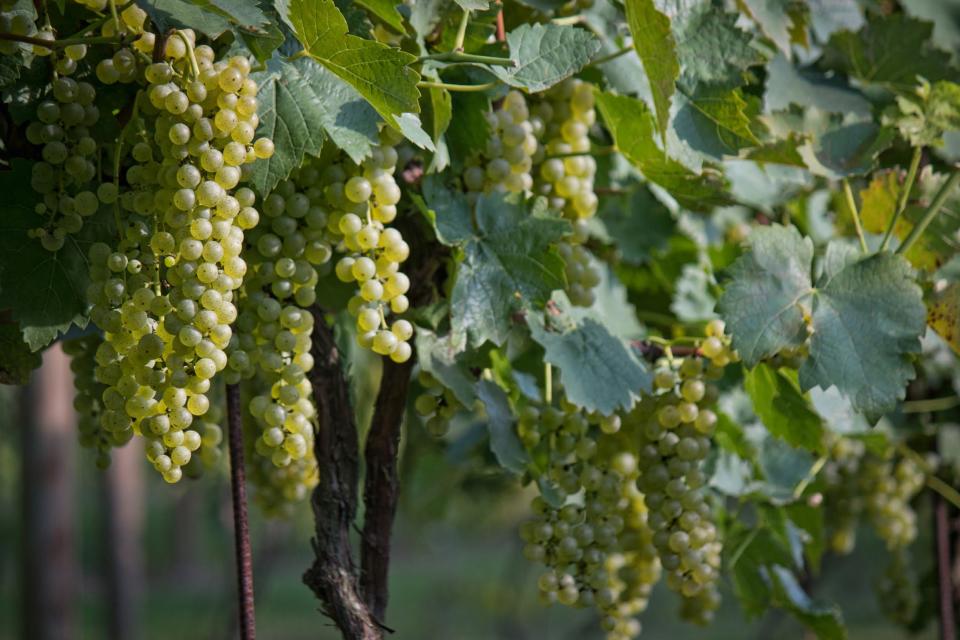The Mountain Grapevine: Tips on grape variety selection and vineyard site selection
So in one of your weaker moments you have decided to grow some grapes. I have met many people who buy the “dream” of owning a vineyard.
“Honey, wouldn’t it be nice to be able to look out over our vineyard (garden) and see our grapevines at sunset while we sip a nice glass of wine we made from them last year?”
Owning a vineyard (even a backyard one) is still farming. It can be hard work.

On the positive side, the work is seasonal. In the spring you plant the grapevines, then set the training sticks, install your posts and trellis wires. When your vines begin to grow, you begin pruning them - typically in the spring. Pruning is an important skill to develop because if you don’t prune properly, you will not get many, if any, grapes. Through the summer you do some mid-season canopy management, and in the fall you harvest.
All relatively short periods of activity but intense work at times. Then harvesting in the fall. Grapes are a perishable crop so you need to be prepared to harvest them in a timely fashion. Once harvested they must be refrigerated or processed immediately. So throughout the year there are various short but intense activities needed in keeping a vineyard.
The first consideration, once you have made the decision to grow grapes, is “What kind of grapes should I grow?” Do spend a bit of time on this because your grape variety decision will be a long term decision that can not be reversed quickly. Decide what you want to do with the grapes you grow. Will you just eat them as table grapes? Make some pies or jelly? Do you want to sell them at a farmer’s market? Do you want to sell them to someone else for processing? Sell them to a winery for their winemaking? Ingredients for medicines or herbal extracts? Raisins? There are more than 150 products that can be made from grapes.
The final suggestion - make sure you know what you are going to do with the grapes you grow BEFORE you plant them. Most properly pruned vinifera and hybrid grapes will yield about 12-16 pounds of grapes per vine. Muscadines will produce 50-80 pounds per vine. Using these numbers will allow you to calculate how many vines to plant. For example: Making wine at home? It takes about 85 pounds of muscadine grapes to make 5 gallons of wine, so two mature muscadine grapevines will do the trick for you.
Based upon your intended use for the grapes, you may choose to grow vinifera (European varieties), French-American hybrids, or native American grapes including muscadines. Once that decision is made, you need to decide if you plan to grow them using traditional methods (spraying), natural methods, organic or biodynamic methods. I am basically a lazy grape-farmer so I like to grow what grows best in our dirt with the least amount of effort - naturally.
I prefer to work with nature instead of fighting against nature. No chemicals have ever been used in my Katuah muscadine vineyard. The balance of this series will be about the best grape to grow in the mountains of Western N.C.: Cold-hardy Katuah muscadines. I found them growing wild in the mountains of Madison County and spent three years of my life learning how to propagate them. Definitely one of the more difficult tasks in my lifetime.
One of the most common mistakes made by people hoping to plant a new vineyard in the mountains is vineyard site selection. The most important point is to select a south-facing slope for your vineyard location. The weather in the mountains of WNC creates a nearly full-time early morning high humidity condition that is not good for most grapes. High humidity promotes certain grape diseases like downey mildew and black rot.

The ever-present early morning fog in the mountains causes water to stay on the leaves until the sun comes up and burns off the fog, so planting on southeasterly slopes hastens the drying of the leaves. Southwesterly-facing slopes will be OK if you plant the kind of grapes that are disease resistant. Try to select an area where you won’t have to cut down trees to plant a vineyard. Some grape farmers I know have planted on hills so steep they have to terrace their vineyard rows.
Planting on top of a mountain is a bad idea since it is very cold up there and the wind blows nearly non-stop. Our vineyard in Marshall is at 2,100 feet elevation on south-facing slopes of 30-45 degrees. Your vines may suffer a lot of winter damage because of the temperatures, even if you have selected cold-hardy varieties. It is even worse to plant a vineyard in the bottom of a valley. Cold air settles there and is trapped all night so you can expect to have even more winter damage to your vines if you select a site in the bottom of a valley.
The ideal location is on the slopes between the top of the mountain and the low valley. This location will always be warmer because of the nearly constant flow of air down the slopes. Backyard grape growers should pick a spot where the grapes will get about eight hours of sunshine every day. Flat land is OK, but not if the soil is constantly wet. Grapevines don’t like wet feet, so make sure you have good soil drainage.
True, it is easier to plant and manage a vineyard on flat land with perfectly good soil without a lot of rocks. However, it is the nature of the topography in WNC that some locations have a lot of rocks while other locations have very few rocks. Most vineyard site choices here in WNC will contain some combination of soil and rocks.
So think carefully about what kind of grapes you want to grow and how you want to grow them. Select a place on your farm/garden that will grow grapes the best. Think, plan, then plant!
Chuck Blethen is a Madison County vigneron, author, lecturer and co-owner of Jewel of the Blue Ridge Vineyard & Walapini Nursery. He is the vice president of public relations for the French Broad Vignerons of WNC. He can be reached at Chuck@JeweloftheBlueRidge.com or 828-606-3130.
This article originally appeared on Asheville Citizen Times: Mountain Grapevine: Tips on grape variety, vineyard site selection

